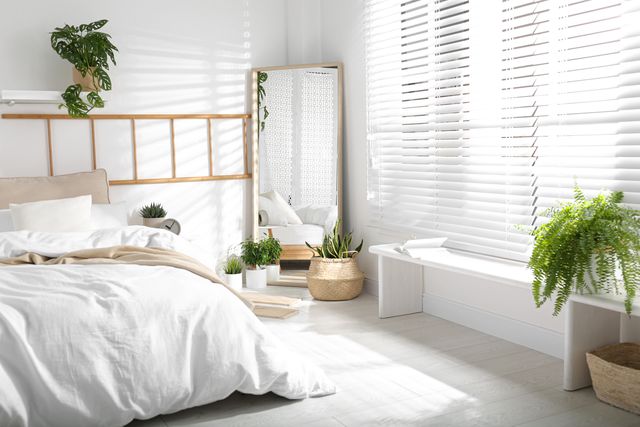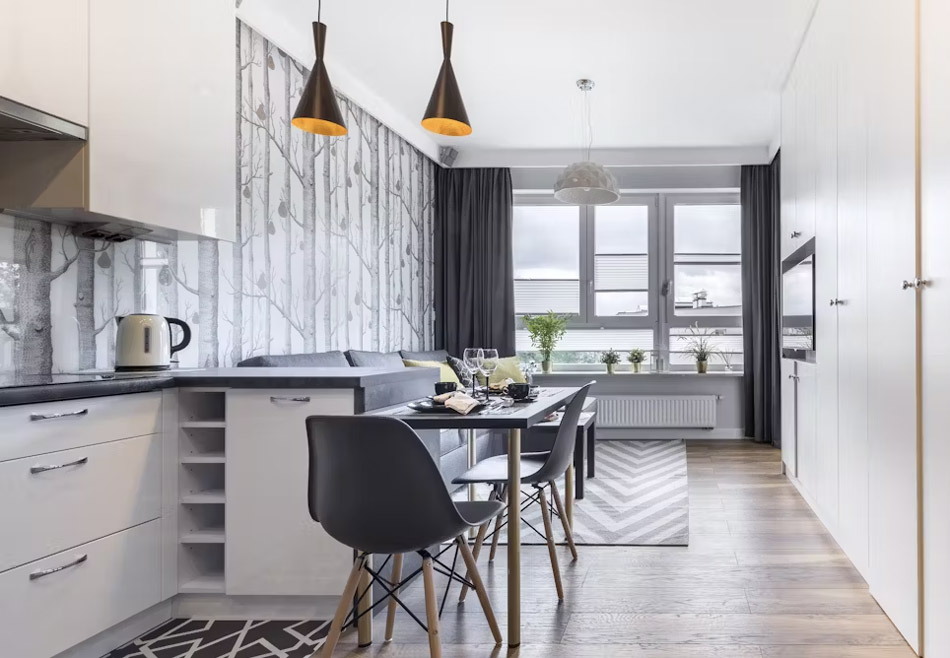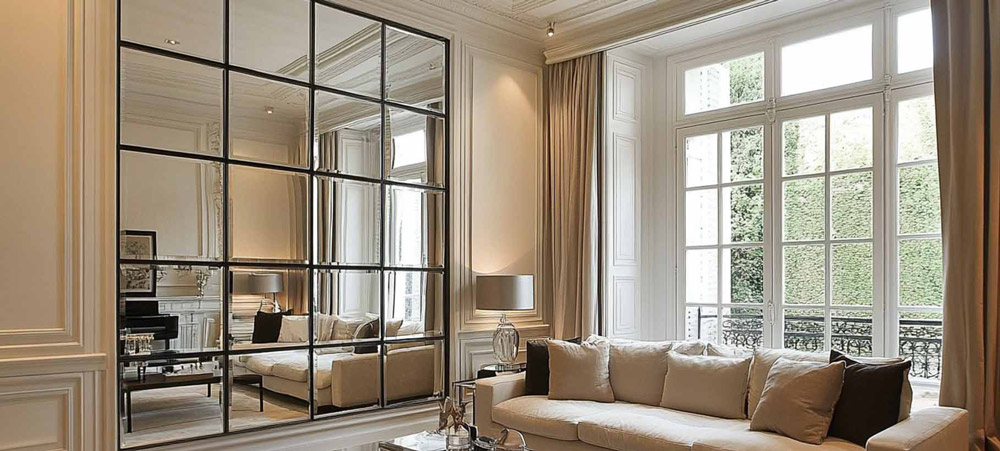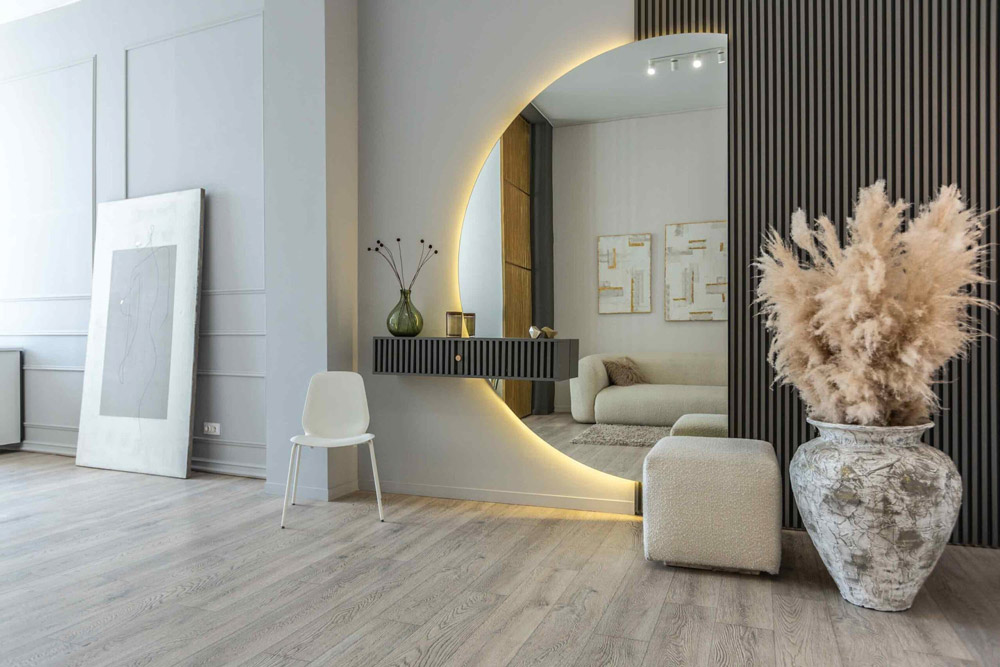Mirrors are one of the most underrated tools in interior design. Beyond their practical use for checking your reflection, mirrors play a powerful role in shaping how light moves through a space and how large a room feels. Whether you’re working with a small studio apartment or a dimly lit hallway, using mirrors strategically can dramatically improve both illumination and the sense of openness.
This article explores how mirrors enhance natural and artificial lighting, how they create the illusion of space, and the best ways to integrate them into your home or office.
Contents
Enhancing Natural and Artificial Light with Mirrors
One of the most immediate benefits of using mirrors is their ability to amplify both natural and artificial light. When placed correctly, mirrors bounce light around a room, making it feel brighter and more welcoming.

Reflection Principles
Mirrors reflect light due to their polished surfaces, sending it back into the room rather than absorbing it like many wall materials. A well-placed mirror can capture sunlight coming through a window and scatter it across a darker section of the room, significantly improving brightness without the need for extra lamps or fixtures.
Placement for Maximum Brightness
To maximize light, mirrors should be placed directly across from or adjacent to windows. This allows them to reflect the incoming natural light deeper into the room. If natural light is limited, positioning mirrors near artificial light sources such as pendant lights, wall sconces, or floor lamps can produce a similar effect.
For example, a mirror behind a table lamp or beside a wall-mounted fixture can double the perceived light source, making the room feel more vibrant and lively.
Different Mirror Types and Their Effects
Not all mirrors perform the same. A large, frameless mirror offers a clean, expansive reflection, ideal for modern, minimalist interiors. Framed mirrors, on the other hand, add an element of design that complements traditional or rustic spaces.
Tinted or antiqued mirrors create a softer, moodier reflection that diffuses light more subtly. These are often used in dining rooms or lounges where ambiance is key.
Creating the Illusion of Space
In addition to brightening a space, mirrors are excellent at making rooms appear larger than they are. This is particularly useful in urban apartments, small offices, or narrow entryways.

Visual Illusions
Mirrors visually extend a room by reflecting walls, ceilings, and furniture. This creates the impression that there’s more space than actually exists. It’s a psychological trick rooted in our visual perception; our brains interpret the reflection as part of the room’s depth.
Strategic Placement for Room Enlargement
In small rooms, a floor-length mirror leaning against the wall can draw the eye upward and outward, making ceilings seem taller and the room wider. In tight hallways or corridors, horizontal mirrors can visually elongate the space, reducing any sense of confinement.
Placing a mirror behind furniture, such as a sofa or bed, also increases the room’s perceived depth and breaks up visual monotony.
Ceiling and Floor Reflections
For a more dramatic impact, mirrors can be installed on ceilings or used as mirrored floor tiles. Ceiling mirrors lift the vertical dimension, which is especially useful in rooms with low ceilings. Mirrored floors are less common but can create a futuristic, high-design look in luxury spaces or retail environments.
Interior Design Techniques with Mirrors
Interior designers use mirrors not just for light and space but also as statement pieces. When chosen carefully, mirrors can become the focal point of a room.
Focal Point Creation
Large mirrors with ornate or bold frames can act as decorative anchors in living rooms or entryways. A sunburst mirror above a fireplace or a vintage gold-framed piece in a hallway immediately draws attention and adds character.
Mirror Walls and Panels
Full mirrored walls were once considered outdated, but modern design has brought them back in sophisticated ways. Using mirror panels with bevelled edges or geometric patterns can add texture and depth to a room without overwhelming it.
This approach is especially effective in dining areas, gyms, and commercial lobbies where you want a sense of grandeur without using traditional wall art or heavy decoration.
Mirrored Furniture
Mirrored furniture pieces like coffee tables, dressers, and nightstands reflect their surroundings, which helps maintain visual continuity in the room. This can prevent bulky items from feeling obtrusive, especially in minimalist spaces.

Mistakes to Avoid When Using Mirrors
While mirrors offer many advantages, they can backfire when misused. Awareness of common pitfalls will help ensure the best outcome.
Overuse or Wrong Placement
Too many mirrors can make a space feel disjointed or dizzying. Overuse can also create awkward sightlines or excessive glare, especially if mirrors face each other. This can lead to endless reflections that disrupt the sense of balance in the room.
Safety Considerations
In households with small children or pets, large freestanding mirrors should be securely anchored. Avoid placing mirrors in areas where they could easily be knocked over or damaged.
Style Mismatches
A mirror that clashes with the room’s decor can feel out of place. For example, a modern frameless mirror may look stark in a cozy, farmhouse-style room. Consider the material, shape, and frame to match the existing design elements.
Real-Life Examples
In urban homes where windows are limited, placing a tall mirror adjacent to the window has helped double the incoming light, giving rooms a fresh and airy feeling. In retail boutiques, mirrors are often used behind shelves or on dressing room doors to create the perception of a larger, more open space. High-end hotels frequently use mirrored wall panels in hallways to eliminate the sense of enclosure and maintain a sleek, luxurious look.
Conclusion
Mirrors are a versatile and practical tool in interior design. When used thoughtfully, they can dramatically improve a room’s lighting, increase the perceived size of a space, and add stylish accents to your décor. Whether you’re trying to brighten a dark room, open up a small area, or simply add a touch of elegance, mirrors offer a flexible solution that combines function with form.
By understanding the principles of mirror placement and avoiding common mistakes, homeowners and designers can unlock the full potential of reflective surfaces in their spaces.

